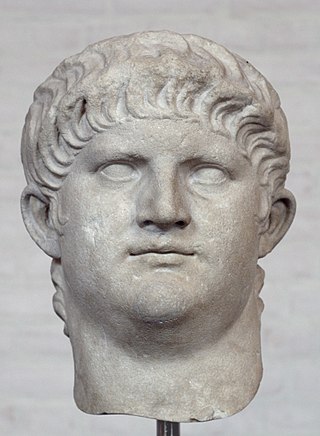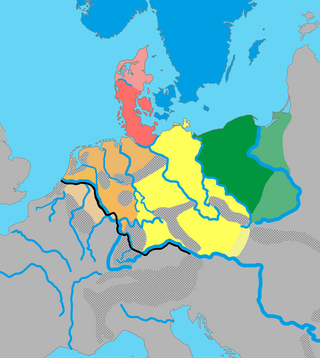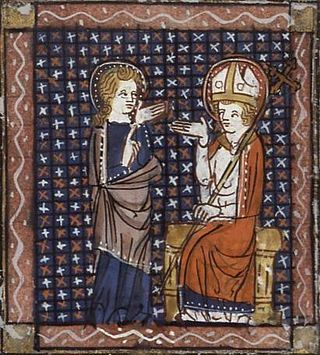
The Burgundians were an early Germanic tribe or group of tribes. They appeared in the middle Rhine region, near the Roman Empire, and were later moved into the empire, in eastern Gaul. They were possibly mentioned much earlier in the time of the Roman Empire as living in part of the region of Germania that is now part of Poland.

Martin of Tours, also known as Martin the Merciful, was the third bishop of Tours. He has become one of the most familiar and recognizable Christian saints in France, heralded as the patron saint of the Third Republic, and is patron saint of many communities and organizations across Europe. A native of Pannonia, he converted to Christianity at a young age. He served in the Roman cavalry in Gaul, but left military service at some point prior to 361, when he became a disciple of Hilary of Poitiers, establishing the monastery at Ligugé. He was consecrated as Bishop of Caesarodunum (Tours) in 371. As bishop, he was active in the suppression of the remnants of Gallo-Roman religion, but he opposed the violent persecution of the Priscillianist sect of ascetics.

Nero Claudius Caesar Augustus Germanicus was Roman emperor and the final emperor of the Julio-Claudian dynasty, reigning from AD 54 until his death in AD 68.
Sulpicius Severus was a Christian writer and native of Aquitania in modern-day France. He is known for his chronicle of sacred history, as well as his biography of Saint Martin of Tours.

The Chatti were an ancient Germanic tribe whose homeland was near the upper Weser (Visurgis), whose name might mean "pursuers". They lived in central and northern Hesse and southern Lower Saxony, along the upper reaches of that river and in the valleys and mountains of the Eder and Fulda regions, a district approximately corresponding to Hesse-Kassel, though probably somewhat more extensive. They settled within the region in the first century BC. According to Tacitus, the Batavians and Cananefates of his time, tribes living within the Roman Empire, were descended from part of the Chatti, who left their homeland after an internal quarrel drove them out, to take up new lands at the mouth of the Rhine.

Gregory of Tours was a Gallo-Roman historian and Bishop of Tours during the Merovingian period and is known as the "father of French history." He was a prelate in the Merovingian kingdom, encompassing Gaul's historic region.
Servius Sulpicius Rufus, was a Roman orator and jurist. He was consul in 51 BC.
The gens Sulpicia was one of the most ancient patrician families at ancient Rome, and produced a succession of distinguished men, from the foundation of the Republic to the imperial period. The first member of the gens who obtained the consulship was Servius Sulpicius Camerinus Cornutus, in 500 BC, only nine years after the expulsion of the Tarquins, and the last of the name who appears on the consular list was Sextus Sulpicius Tertullus in AD 158. Although originally patrician, the family also possessed plebeian members, some of whom may have been descended from freedmen of the gens.

The Ampsivarii, sometimes referenced by modern writers as Ampsivari, were a Germanic tribe mentioned by ancient authors.

The Bructeri were a Germanic tribe in Roman imperial times, located in northwestern Germany, in present-day North Rhine-Westphalia. Their territory included both sides of the upper Ems and Lippe rivers. At its greatest extent, their territory apparently stretched between the vicinities of the Rhine in the west and the Teutoburg Forest and Weser river in the east. In late Roman times they moved south to settle upon the east bank of the Rhine facing Cologne, an area later associated with the Ripuarian Franks.

The Istvaeones were a Germanic group of tribes living near the banks of the Rhine during the Roman Empire which reportedly shared a common culture and origin. The Istaevones were contrasted to neighbouring groups, the Ingaevones on the North Sea coast, and the Herminones, living inland of these groups.
Marcomer, also spelled Marcomeres, Marchomer, or Marchomir was a Frankish Dux in the late 4th century who assisted in an invasion of the Roman Empire in the year 388, as the usurper and leader of the whole of Roman Gaul, Magnus Maximus, was surrounded by Theodosius I in the city of Aquileia.

The Chamavi, Chamãves or Chamaboe (Χαμαβοί) were a Germanic tribe of Roman imperial times whose name survived into the Early Middle Ages. They first appear under that name in the 1st century AD Germania of Tacitus as a Germanic tribe that lived to the north of the Lower Rhine. Their name probably survives in the region today called Hamaland, which is in the Gelderland province of the Netherlands, between the IJssel and Ems rivers.

Brice of Tours was a 5th-century Frankish bishop, the fourth Bishop of Tours, succeeding Martin of Tours in 397.
Sunno was a leader (dux) of the Franks in the late 4th century who invaded the Roman Empire in the year 388 when the usurper and leader of the whole of Roman Gaul, Magnus Maximus was surrounded in Aquileia by Theodosius I.

Marmoutier Abbey — also known as the Abbey of Marmoutier or Marmoutiers — was an early monastery outside Tours, Indre-et-Loire, France. In its later days it followed the Benedictine order as an influential monastery with many dependencies.
Genobaud was a leader (dux) of the Franks. He invaded the Roman Empire in the year 388.
Renatus Profuturus Frigeridus was a fifth-century historian. He wrote a historical work of twelve volumes. It exists today only in brief fragments, a few passages having survived in chapters eight and nine of the second book of Gregory of Tours' Decem libri historiarum. Gregory likewise preserves some quoted material from the late fourth-century historian Sulpicius Alexander.
Donald Gregory (1803–1836) was a Scottish historian and antiquarian, who published a valuable history of the Western Highlands and Isles of Scotland.

Publius Sulpicius Quirinius, also translated as Cyrenius, was a Roman aristocrat. After the banishment of the ethnarch Herod Archelaus from the tetrarchy of Judea in AD 6, Quirinius was appointed legate governor of Syria, to which the province of Judaea had been added for the purpose of a census.









